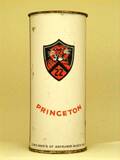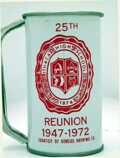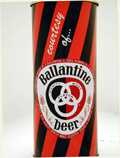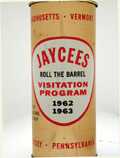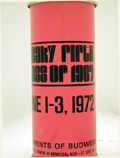
Test cans and commemorative cans are both examples of beer cans that were never produced in large quantities. They are also amongst the most interesting cans to be produced. Prior to introducing a new product, a brewery will go through an extended process of market research to determine whether or not new product should go into production. A big part of this research go towards the package design. This page will feature a number of test cans from the Schlitz brewery representing the various stages of the can evaluation process.
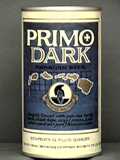
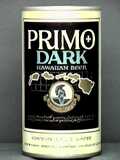
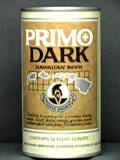
|
The Primo cans are all hand drawn one-of-a-kind prototypes.
The Primo Dark can never
made it into production.
A proposed can or bottle label design will start with simple sketches. The best of these will be hand drawn by graphics artists. These designs will be wrapped around an actual beer can to get an initial impression of the how the final design will appear. Primo of Hawaii considered introducing a Primo
Dark beer. The three Primo Dark cans depicted here are all hand drawn samples of featuring different background colors. At the low resolution of the photographs shown here, it is difficult to distinguish them from actual metal beer cans. If the design passes this first stage, then more money is invested in better quality paper label design.
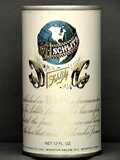
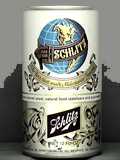
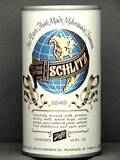
|
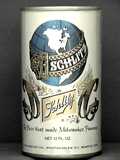
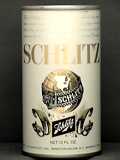
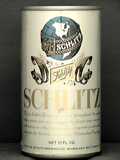
|
These are all high quality paper label Schlitz cans under consideration in the 1970's. They drew inspiration from the Schlitz logo circa 1900. They never made it into production either.
In this next phase, a more sophisticated printing process is used to develop the paper label that is very representative of how the final can will appear. Pictured at left are several cans that were considered as candidates for a new Schlitz can in the 1970's. They drew inspiration from some of the turn-of-the-century Schlitz advertising. These cans all place emphasis on the Schlitz globe. All are paper label test cans that never made it into production. Ironically, Schlitz went from being the number one beer in America as recently as the 1950's to being practically non-existent in the year 2000. Schlitz chose not to make anything resembling a radical move with their flagship product. Instead, they opted to refine their existing can design. Below are pictured several candidates that were considered.
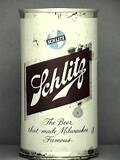
|
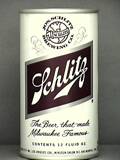
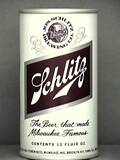
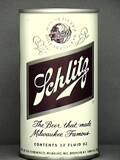
|
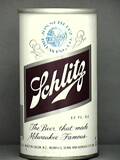
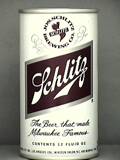
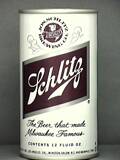
|
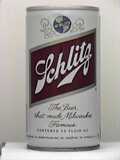
|
The test cans in the middle two rows were considered as replacements
for the can at the top. They are actual beer cans but never contained
beer. The can at the bottom reflects the eventual design. As you can
see it is nearly identical to the old production can shown at top.
The next series of cans went beyond the paper label
phase and are actual steel beer cans. As you can see, they are little more than subtle refinements with special emphasis on the globe. They really wanted to get that Schlitz globe just right. Some of these cans were actually filled with beer and test marketed. The can pictured on the top row, far left, is their old design from the 1960's. The final can pictured is an example of a Schlitz can from around 1980. It is quite clear that the folks at Schlitz decided that their 1960's style can wasn't so bad after all.
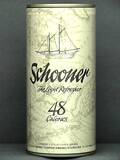
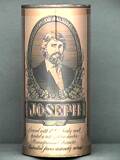
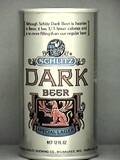
|
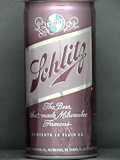
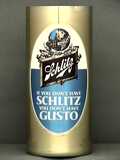
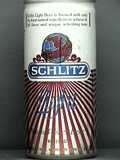
|
Other candidate Schlitz products that never made it to market including these wild looking Schlitz cans on the bottom.
Schlitz gave quite a bit of consideration to a number of other products that never made it to market. Among those under consideration were a number of Schlitz Dark and a number of Schlitz Light products. The company also considered new brands including Reno, Schooner, and Joseph - named after their founder Joseph Schlitz. Schlitz was not the only brewery to go through this process. Most early test cans are destroyed or locked up in a brewery back room. The Schlitz cans are featured here since the collectors at beercans.org have been lucky enough to acquire a number of these cans. More often than not, these early test cans get destroyed or locked up by the brewery.
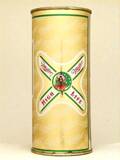
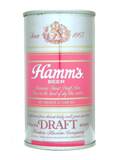
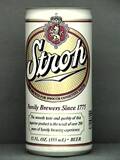
|
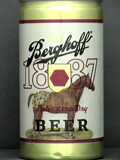
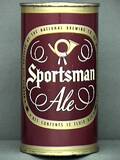
|
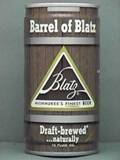
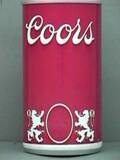
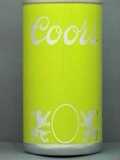
|
Test Cans from various U.S. brewers.
At left are test cans from several other breweries. The first can features the classic Miller girl on the moon symbol. This symbol dates from the turn of the century and was prominently featured in early advertising and cans. This test can featured the old logo on the new design gold beer cans. The red Hamms can never made it into production. Instead Hamms went with a blue and grey can in the special shape of a barrel. The can at upper right reads Stroh instead of the usual Stroh's. The brewery of the same name in Fort Wayne, Indiana originally brewed Berghoff beer. The Walter Brewery of Pueblo, CO later produced it. This can came from the Pearl Brewery of San Antonio and featured a draft horse. The Sportsman Ale from National Brewing of Detroit is a paper label mockup can. The Blatz can at bottom tested a new special barrel shape can offered by the can makers. The Coors cans at the bottom feature the familiar Coors font but little else in a very plain can.
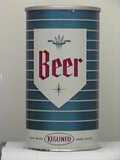
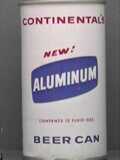
|
Sample cans from the can makers. The can at left features National Can's
keglined trademark while Continentals can promotes aluminum.
Can makers produce their own sample cans to introduce new packaging concepts.
Shortly after the end of prohibition, can makers worked to convince brewers to package their product in cans. Naturally they brought along can samples to the breweries. An early American Can sample featured a wild colorful drinking scene. A 1950's sample can from American, shown at left, highlights their
Keglined trademark for beer cans. Also pictured is a sample can from Continental that promotes aluminum beer cans.
When the beer can was first introduced a number of breweries hedged their bets by not placing their flagship product into the can. Instead they placed something called their export beer. The rational was that any bad tasting brew that was spoiled by the can would not be attributed to their principle brands. These early export brands were not necessarily exported. The next series of cans on this page have been produced for export only.
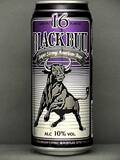
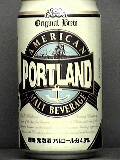
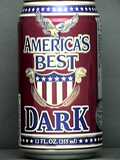
|
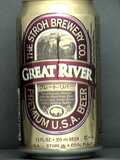
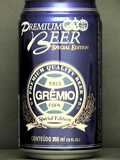
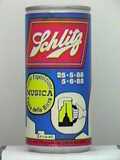
|
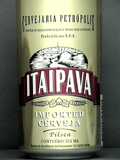
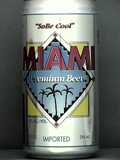
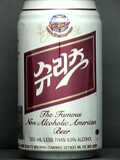
|
Export cans. Most of the cans pictured were brewed in the U.S. but never sold in the U.S.
Export cans fit into the category of limited production cans. As the number of breweries have dwindled since prohibition, so too have the variety of cans of the market. There has been one notable exception to this rule- this being beer for export. The lighter weight and greater compactness of cans versus bottles is especially important when they are shipped long distances. For this reason most beer is exported in cans. More often than not the cans do not carry the name of their brewery but rather special brands designed to appeal to the foreign beer buyer. The Itaipava and Gremio are designed to appear as South American brands. On the other hand brews such as Portland, America's Best, Great River (Stroh) and Miami use their U.S. origin as a selling point. They often list bogus brewery names on the side panel that have been conjured up by the exporter. The Itaipava, for example, lists the St. Andrews Brewery of Dallas. Breweries including Stroh, Rainier, Weinhard, and Evansville made the various beers under contract. They viewed export brands as another method to generate income. The Rainier, Weinhard, and Evansville breweries have now all closed. Schlitz did sell their own brand overseas. The can at bottom right features the Schlitz logo written in Japanese. The Schlitz can at right in the middle row is a paper label can sold at an Italian festival. Schlitz and later Stroh's sold their famous malt liquor under a number of names Cans of the Month, July 1999 . These cans are very difficult to find in their home country.
Another group of limited edition beer cans are the special commemorative cans.
The most popular of these are the class reunion cans. Over the years breweries have sponsored class reunions by providing free beer and often provided special drinking cups in the form of a can. These cans typically were produced without a top to be used as a drinking cup. They instead have a smooth rolled edge at the top. In some cases, a handle is often built into the can. For some strange reason almost all of the cans are for Ivy League schools. Cans have been produced for Dartmouth, Cornell, Harvard, and most of all for Princeton. I am not sure if this is due to strong school spirit or well placed alumni. A number of people have made the comment that the Harvard and Princeton alumni may be the people least in need of a free beer. Genesee has supplied its close neighbour Cornell with a number of cans. Carling provided cans from its Massachusetts brewery to Harvard and Dartmouth. Carling, Ballantine and Anheuser-Busch, both with breweries in New Jersey, were frequent suppliers to Princeton. These cans almost always featured a Princeton tiger. The can at the upper left commemorates the 25th anniversary of the class of 1943. The can at upper right celebrates the Princeton class of 1922. It is probably from 1962. The can at lower left commemorates the fifth anniversary of the class of 1967. The Ballantine at the lower left is undated. The reverse features a large "P". The can featured in the middle of the bottom row is bank can for the Jaycee's Roll out the Barrel program. The final can is a highly unusual high school eunion can. This can from Genesee salutes the 25th anniversary of the Ithaca, New York High class of 1949.
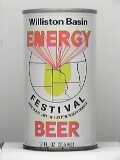
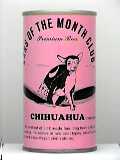
|
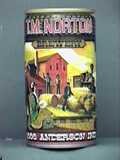
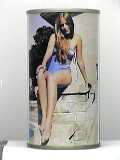
|
These commemortive cans helped regional breweries stay alive in the late 1970's.
Another type of commemorative can came out at the height of the beer can collecting craze in the late 1970's. These were commemorative cans aimed directly at the beer can collector. They were seen by a number of smaller breweries as a good strategy to keep the brewery afloat in a highly competitive market. The Schell Brewery of New Ulm, Minnesota and the Walter of Eau Claire, Wisconsin were especially active. They were sold at not-so-popular high prices. The Williston Basin Energy Festival can from Schell is a good example of this. The seven Cans of the Month from Pickett of Dubuque, Iowa featured breeds of dogs. It didn't take long for collectors to grow weary of this type of beer can. There were some appealing cans to be issued. Huber Brewing of Monroe, Wisconsin issued a set of eighteen cans commemorating old breweries called the American Brewers Historical Series. Schell issued a set of two dozen Safari cans which displayed African scenes and the nine can Sugar and Spice set featuring attractive women.
The Schell brewery and the Huber brewery are thankfully still operating today.
Huber later made most of the popular Harley-Davidson beer cans.
The cans pictured on this page have all been produced in quantities well below the typical beer can. However, the have never had the same type of appeal amongst collectors as actual production cans.
Home














































